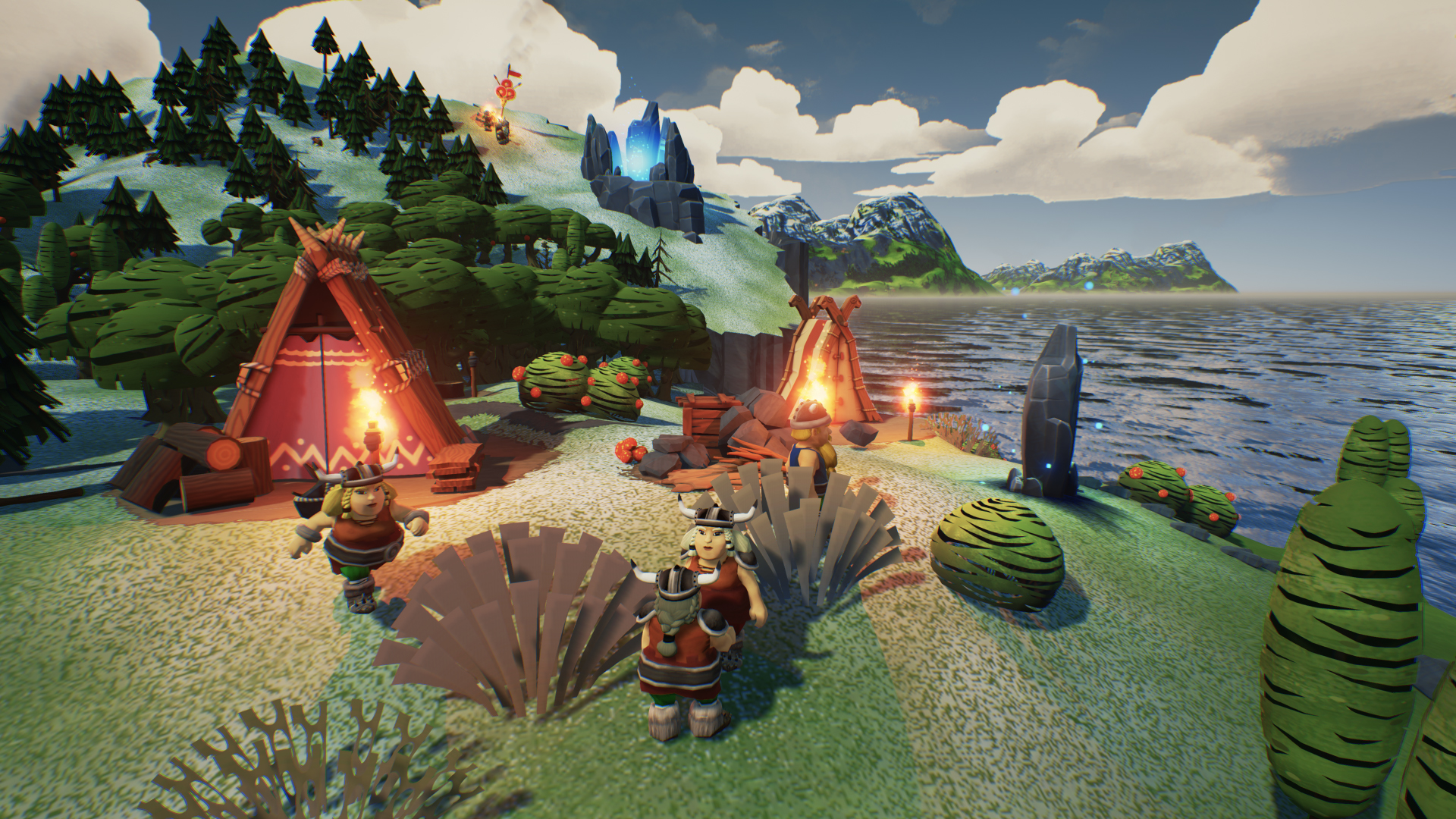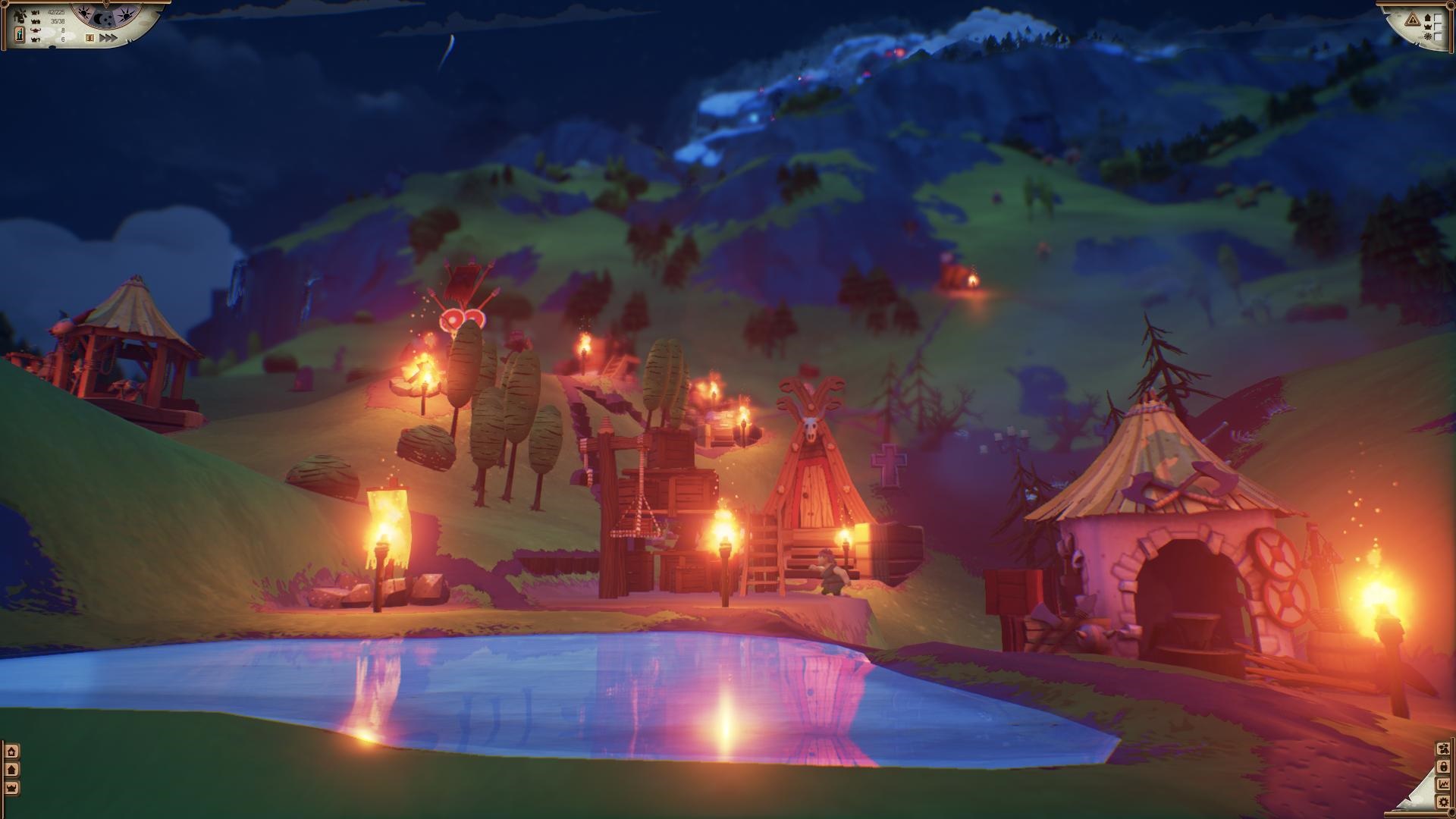There are a good number of genres I feel comfortable reviewing: shooters, RPGs, platformers, action…but I wouldn’t count strategy among them. My experience in strategy games (aside from XCOM and Final Fantasy Tactics) is that of an enthusiast at best. So, it was with the perspective of a novice that I set out to review Valhalla Hills, which, perhaps because of my ignorance, I don’t even know how to properly categorize. It doesn’t play like StarCraft or Total Annihilation, only sharing their top-down perspective, and you don’t really worry about troop mixture for battles so much as you worry about resources, but I’m getting ahead of myself.
The story of Valhalla Hills, loose though it may be, is about a young Norse god of building and construction. Odin, apparently frustrated that his son didn’t want to become the god of something fun like war, thunder, or drinking, banished his son, who then decided to earn his re-entry to Asgard by redeeming Vikings not honorable enough for Valhalla. Really, though, this all amounts to an opening cinematic and nothing more. There is no dialogue-heavy campaign with various heroes arguing and betraying one another, just a series of missions with a very gentle difficulty curve.
Valhalla Hills is complex, but in a simple way. At the most basic level, your job is resource management, like a big City Planner of the Gods, with the only truly finite resource being your population. Each mission begins on a randomly generated map with a handful of Vikings and some basic resources to get you started, like lumber, leather, and stone. Once you decide which structure is to be built where, one of your Vikings will take the available resources to construct the building and then immediately begin working the job associated with it. One of the first buildings you should construct, for example, is a tool shed to make axes, hammers, and so forth, and as soon as your Viking finishes making the shed, he’ll stand at the ready to take orders for which tools you’d like him to make for the other Vikings in your village. Once he’s been given an order, he’ll wander about looking for the materials needed to complete that order. If it’s readily available, he’ll carry the supplies back to the shed and start working, but if it isn’t, he’ll stand around bored.
The game becomes one of trying to stay a step ahead of the projects you set up. Your Vikings need food, for example, but you can’t just build a bakery and feed the masses. You need to grind wheat for the bread, so you’d better build a mill, and before the mill a wheat farm, and a sickle so the farmer can harvest the wheat, and the material to make the sickle he uses to harvest the wheat, and a tool shed to craft the sickle.
Valhalla Hills isn’t just a wheat farming simulator, though. Ultimately you’re working toward unlocking a gateway that allows you to move toward the next level, with the gateway being guarded by monsters. You can appease the monsters by building an altar and making sacrifices, or you can kill them with an army. I personally preferred using an army, since when I wasn’t using my army to attack the gateway, I was using it to defend the Vikings looking for supplies. There are more beasties out and about than just the gateway guardians, and you can expect to defend your village journeymen from attacking wolves or even the undead.
As you progress through missions, you unlock more and more buildings to make your village more efficient and better suited to meet the challenge…as long as you remember to keep everything well supplied. You’re really creating a little communist Viking community, except with Vikings happily starving to death if they can’t find any food instead of violently revolting.
If your Vikings do starve to death, though (or become wolf food, which was the main cause of death in all of the villages I built) you will be short one more worker or soldier, and that’s where the game’s challenge lies. Each mission has a set number of Vikings that you are allowed for the entirety of the mission, with the game automatically summoning more Vikings as they’re needed for more work. You may have a limit of 55 Vikings for the entire level, for example, but unless you have enough work for 55 Vikings, the game won’t dump all 55 into the level all at once. You can request more than your current allotment if you’d like to, but you’ll want to make sure you have plenty of food if you do. After all, more workers means more mouths to feed. Brass tax, you have to have enough Vikings to attack or appease the monsters guarding your level exit, and if you don’t have food production, tool production, and defense working in synchronicity, you’re going to spend a lot more time on the level than what’s necessary, or lose all your Vikings and need to start over.
In fact, placing the wrong building too early can put you in a rut that might as well make you restart the level, so to say the game is without challenge is certainly not true. It’s the presentation of that challenge that’s surprising, as Valhalla Hills is downright relaxing. The game features soft, easy music and a time-pausing button to let you spend as long as you need thinking about your next decision while you survey your village. The graphics are bright, cheerful, and engaging, with adorable little Vikings that wouldn’t look out of place in a Saturday morning cartoon. It feels almost like a free-roaming puzzle game, but at the same time it certainly has a degree of strategy included in it, only with the focus of that strategy geared more toward resource management instead of military growth.
Valhalla Hills may be somewhat polarizing. Whether or not it suits you is largely going to be a matter of personal taste, as it’s easy for me to imagine as many people finding the game boring as those who find it a fun, relaxing management game. Regardless of personal taste, the game is very well made and accomplishes what it sets out to do quite well, and although I’d like to see more of a structured campaign in the future, Valhalla Hills is still a great buy for its niche audience.
Score 8/10







